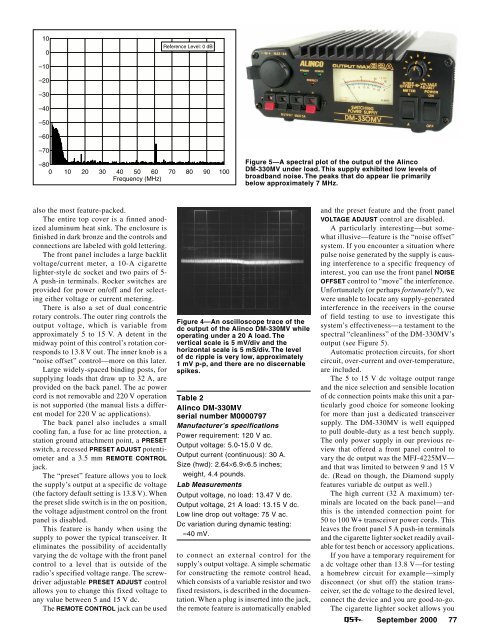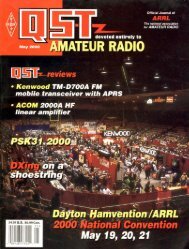through an antenna tuner, and was rewardedwith a rush of signals. I tuned around a bitand found a station calling CQ and gave hima quick call. He came back with a 579 report—notbad considering I was transmittingwith just 2 W of RF power!I am suitably impressed with the MFJCub—the more I operate it the more I likeit. It’s important to keep in mind that theCub was never intended to be a “contest”radio—it’s designed to be a simple, relativelyinexpensive transceiver for casualQRP operating.Since the Cub uses only a 3-pole IF crystalfilter, there is some filter “blow by,” andduring evening operation I also noticed that,at least here in the northeast, the 40-meterversion is prone to shortwave broadcastoverload. CW break-in is semi-QSK.One operating characteristic that takes alittle getting use to is that the main tuningdials on the 40- and 80-meter Cubs workbackwards! You turn the tuning knob clockwiseto move down in frequency.Overall, the performance ain’t bad.Room to GrowNow that I’ve completed the kit and verifiedthat it’s working properly, in typicalQRPer fashion, I’m already consideringhow I’d customize it. I’d build in a PICbasedmemory keyer (such as the TiCK orK1EL variety) and maybe add an audio frequencyenunciator like the Small WonderLabs FREQ-Mite. There’s plenty of roominside the case.The manual lists several power amplifiertransistors that can be substituted forthe stock 2N5109 that comes with the kit. Ihad a 2N3553 on hand and have alreadytried installing that device in place of thenormal PA with good results.I also performed one other modification—I’vereplaced the main tuning knobwith a knob of much larger diameter. Thisgreatly enhances the ease of tuning.The Scouting ReportThe Cub is geared for the backpacker,hiker or QRPer on the go. The rig can bepowered by a battery pack made from ahandful of AA cells or, if space and weightisn’t a major consideration, a gel cell. Acollection of two or three Cubs covering avariety of bands could be the start of a greatlittle portable station for camping, businesstrips or vacations.The construction of the Cub is prettyeasy. It seems to me to be an excellentchoice for a first time kit builder. If you arenot interested in spending a few enjoyablehours at the bench, you can order the unitfactory assembled.The performance is decent—especiallywhen you consider the simplicity of thedesign, the price and the intended market.Those who haven’t experienced QRP operationyet will be surprised with how wellthey can do using just a couple of watts anda simple antenna.Manufacturer: MFJ Enterprises, POBox 494, Mississippi State, MS 39762;800-647-1800, fax 662-323-6551, http://www.mfjenterprises.com/.Manufacturer’s suggested list price:$99.95 (kit); $149.95 (wired and tested).Switching Power Supplies RevisitedReviewed by Joe Bottiglieri, AA1GWA comparison product review coveringthe Astron SS-30M, the ICOM PS-85, theKenwood PS-40, the MFJ-4225MV, theSamlex SEC 1223 and the Yaesu FP-1023switching power supplies appeared in theJanuary <strong>2000</strong> issue of <strong>QST</strong>.Since then, two additional manufacturershave added switching supplies to theirproduct lines. This time around we’ll putAlinco’s DM-330MV and Diamond’sGZV4000 through their paces. Please havea look back at the earlier review to get acomplete picture of how these new contendersstack up against their predecessors.We had hoped to take this opportunityto check out an updated version of ICOM’sPS-85. The example of that supply that weevaluated in the previous review exhibitedsome disappointing performance. At thattime, communications with ICOM Americaindicated that an improved version wouldbe available by the time that the January<strong>2000</strong> issue of <strong>QST</strong> had hit the streets. Unfortunately,due to engineering delays (andcontrary to what I reported in the text ofthat review), a redesigned PS-85 has not yetbecome available.A TransformationPerhaps the most noticeable advantagesof switching supplies over their more conventionaltransformer-based cousins arereductions in size and weight. This makesthem especially attractive choices for portableapplications, such as for travel or for76 <strong>September</strong> <strong>2000</strong>use in the field. If the trends that we areseeing in the power supplies of consumerelectronics products are any indicationhowever, switching supplies will be findingtheir way into more and more hamshacks—weight and size considerationsmay soon give way to the forces of simpleeconomics.While early “switcher” designs provedtoo electrically noisy for use with our sensitivereceivers, the results of our Januaryreview prove that most of the currentlyavailable “communications grade” switchingpower supplies are sufficiently quiet forthe vast majority of Amateur Radio use.The TestsWe subjected the Diamond and Alincosupplies to the same battery of tests that weused for the previous evaluations. Theseinclude measurements of the dc output voltageat loads of 1.1 and 21 A, the minimumac input voltage required for the supply toretain proper dc regulation and the amountof dc ripple present on the output.We also put them through the same dynamictest—the supply is connected to atest fixture that rapidly alternates the loadbetween approximately 1.1 and 21 A andthe resulting variation in the output voltageis recorded.The final—and perhaps the most revealing—labtest involves ac coupling the supplyto a spectrum analyzer, connecting aload of approximately 20 A, and generatinga spectral plot of the frequencies between1.5 and 100 MHz.As before, the supplies were field testedby substituting them for the existing dcpower supplies in a variety of station configurations.The Alinco DM-330MVThe DM-330MV is one of the smallestof the switching power supplies that we’velooked at so far, but—paradoxically—it is
100Reference Level: 0 dB–10–20–30–40–50–60–70–800 10 20 30 40 50 60 70 80 90 100Frequency (MHz)Figure 5—A spectral plot of the output of the AlincoDM-330MV under load. This supply exhibited low levels ofbroadband noise. The peaks that do appear lie primarilybelow approximately 7 MHz.also the most feature-packed.The entire top cover is a finned anodizedaluminum heat sink. The enclosure isfinished in dark bronze and the controls andconnections are labeled with gold lettering.The front panel includes a large backlitvoltage/current meter, a 10-A cigarettelighter-style dc socket and two pairs of 5-A push-in terminals. Rocker switches areprovided for power on/off and for selectingeither voltage or current metering.There is also a set of dual concentricrotary controls. The outer ring controls theoutput voltage, which is variable fromapproximately 5 to 15 V. A detent in themidway point of this control’s rotation correspondsto 13.8 V out. The inner knob is a“noise offset” control—more on this later.Large widely-spaced binding posts, forsupplying loads that draw up to 32 A, areprovided on the back panel. The ac powercord is not removable and 220 V operationis not supported (the manual lists a differentmodel for 220 V ac applications).The back panel also includes a smallcooling fan, a fuse for ac line protection, astation ground attachment point, a PRESETswitch, a recessed PRESET ADJUST potentiometerand a 3.5 mm REMOTE CONTROLjack.The “preset” feature allows you to lockthe supply’s output at a specific dc voltage(the factory default setting is 13.8 V). Whenthe preset slide switch is in the on position,the voltage adjustment control on the frontpanel is disabled.This feature is handy when using thesupply to power the typical transceiver. Iteliminates the possibility of accidentallyvarying the dc voltage with the front panelcontrol to a level that is outside of theradio’s specified voltage range. The screwdriveradjustable PRESET ADJUST controlallows you to change this fixed voltage toany value between 5 and 15 V dc.The REMOTE CONTROL jack can be usedFigure 4—An oscilloscope trace of thedc output of the Alinco DM-330MV whileoperating under a 20 A load. Thevertical scale is 5 mV/div and thehorizontal scale is 5 mS/div. The levelof dc ripple is very low, approximately1 mV p-p, and there are no discernablespikes.Table 2Alinco DM-330MVserial number M0000797Manufacturer’s specificationsPower requirement: 120 V ac.Output voltage: 5.0-15.0 V dc.Output current (continuous): 30 A.Size (hwd): 2.64×6.9×6.5 inches;weight, 4.4 pounds.Lab MeasurementsOutput voltage, no load: 13.47 V dc.Output voltage, 21 A load: 13.15 V dc.Low line drop out voltage: 75 V ac.Dc variation during dynamic testing:≈40 mV.to connect an external control for thesupply’s output voltage. A simple schematicfor constructing the remote control head,which consists of a variable resistor and twofixed resistors, is described in the documentation.When a plug is inserted into the jack,the remote feature is automatically enabledand the preset feature and the front panelVOLTAGE ADJUST control are disabled.A particularly interesting—but somewhatillusive—feature is the “noise offset”system. If you encounter a situation wherepulse noise generated by the supply is causinginterference to a specific frequency ofinterest, you can use the front panel NOISEOFFSET control to “move” the interference.Unfortunately (or perhaps fortunately?), wewere unable to locate any supply-generatedinterference in the receivers in the courseof field testing to use to investigate thissystem’s effectiveness—a testament to thespectral “cleanliness” of the DM-330MV’soutput (see Figure 5).Automatic protection circuits, for shortcircuit, over-current and over-temperature,are included.The 5 to 15 V dc voltage output rangeand the nice selection and sensible locationof dc connection points make this unit a particularlygood choice for someone lookingfor more than just a dedicated transceiversupply. The DM-330MV is well equippedto pull double-duty as a test bench supply.The only power supply in our previous reviewthat offered a front panel control tovary the dc output was the MFJ-4225MV—and that was limited to between 9 and 15 Vdc. (Read on though, the Diamond supplyfeatures variable dc output as well.)The high current (32 A maximum) terminalsare located on the back panel—andthis is the intended connection point for50 to 100 W+ transceiver power cords. Thisleaves the front panel 5 A push-in terminalsand the cigarette lighter socket readily availablefor test bench or accessory applications.If you have a temporary requirement fora dc voltage other than 13.8 V—for testinga homebrew circuit for example—simplydisconnect (or shut off) the station transceiver,set the dc voltage to the desired level,connect the device and you are good-to-go.The cigarette lighter socket allows you<strong>September</strong> <strong>2000</strong> 77
- Page 6 and 7:
September 2000 Volume 84 Number 9C
- Page 11 and 12:
THE AMERICAN RADIORELAY LEAGUE INCT
- Page 14:
Get to Know Your Section ManagerThe
- Page 18:
Cosponsors for S.2183Introduced by
- Page 22 and 23:
Calling All Holiday Photos!Calling
- Page 26 and 27:
CORRESPONDENCEYour opinions count!
- Page 30 and 31: By David Blaschke, W5UNMBAThe Might
- Page 32 and 33: By Bill Wageman, K5MATGrid Chasing:
- Page 34 and 35: By Dan Wissell, N1BYTThe OCR II Rec
- Page 36 and 37: 34 September 2000 Figure 1
- Page 38 and 39: its signal in a general-coverage re
- Page 40 and 41: By Dick Goodman, WA3USGThe Monster
- Page 42 and 43: Figure 4—Schematic diagram of the
- Page 44 and 45: elative power levels of the control
- Page 46 and 47: The elegant Butterfly with its ATVp
- Page 48 and 49: Ross Hull, 3JU, at his station inMe
- Page 50 and 51: By Jean Wolfgang, WB3IOSJamboree On
- Page 52 and 53: By Lew Malchick, N2RQSchool Club Ro
- Page 54 and 55: By Dave Patton, NT1NARRL Board Thin
- Page 56 and 57: Summary of Major Board ActionsMinut
- Page 58 and 59: Manager, delivered his report on th
- Page 60 and 61: ucts, and promote more efficient us
- Page 62 and 63: Figure 3—To change your display c
- Page 64 and 65: ity suffers. That is, it’s more d
- Page 66 and 67: in building a higher-performance re
- Page 68 and 69: SHORT TAKESEZNEC 3.0 for WindowsBy
- Page 70 and 71: HINTS & KINKSDOX CONTROL FOR A YAES
- Page 72 and 73: HAPPENINGSARRL Says Amateur Service
- Page 74 and 75: Seminole County to erect a 35-foot
- Page 76 and 77: Reviewed by Rich Arland, K7SZQST Co
- Page 80 and 81: to use lighter plug equipped vehicl
- Page 82 and 83: PUBLIC SERVICEThe Trials and Reward
- Page 84 and 85: HOW’S DX?Tristan da Cunha and Gou
- Page 86 and 87: THE WORLD ABOVE 50 MHZInto the 21st
- Page 88 and 89: were more than half a dozen 2-meter
- Page 90 and 91: health, safety and aesthetics conce
- Page 92 and 93: AMATEUR SATELLITESA “Hot” After
- Page 94 and 95: Christopher R.Gonyea, KB1AZKGoshen,
- Page 96 and 97: QRP POWERVintage QRPFiring up an ol
- Page 98 and 99: HAMFEST CALENDAR† ARRL HamfestAtt
- Page 100 and 101: Mobile to the Max















